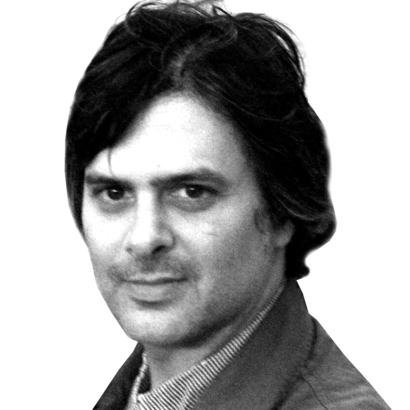Roger McGuinn sometimes called the Byrds—the five-piece band he co-founded in 1964, which went on to become, at least for a time, America’s answer to the Beatles—an “electronic magazine.” As a musical phenomenon, they were, in fact, magazine-like: an ever evolving omnibus of styles and genres, image and storytelling, fashion and culture. During a decade when West Coast American music poured forth from radios and hi-fis around the world, the Byrds reflected their times, week to week, month to month.
Now the surviving original Byrds—McGuinn, Chris Hillman, and David Crosby—have spun out their saga in a whopping, 396-page limited-edition photographic odyssey of an art book called The Byrds: 1964–1967, which includes their own, typically puckish, commentary. (Gene Clark and Michael Clarke, who completed the quintet, both died in the early 1990s; McGuinn steered the band through various permutations into the 1970s.)
Much like the Byrds, who invented folk rock in 1965 with their ecstatic version of Bob Dylan’s “Mr. Tambourine Man” (thereby helping to inspire Dylan himself to go electric) and went on to become founding fathers of psychedelic rock, jazz rock, and country rock, the book is smart, stylish, and ambitious, not to mention nonstop fun.
It’s a visual ode to a seductive, sun-dappled time, of “five bland Apollonians” (as a music producer once described the Byrds) who embodied California cool.
Through the viewfinders of such practitioners as Henry Diltz, Guy Webster, Jim Marshall, Barry Feinstein, and Linda McCartney (née Eastman), we see the Byrds onstage during their epoch-making shows at Ciro’s on the Sunset Strip (with Dylan joining in on harmonica), goofing around at Hillman’s house in Laurel Canyon, laying down tracks at Columbia studios in L.A. (it was Miles Davis who urged the label to sign them), wandering around London during a semi-disastrous tour, and playing the first-ever rock festival, at Mount Tamalpais, on a golden afternoon in 1967: a sparkling moment before Crosby was bounced from the band for being a pain in the neck.

Throughout, the accessories of choice are Rickenbacker and Gretsch electric guitars, smoldering cigarettes, and Porsche 911s. Image, it seems, came naturally to the photogenic Byrds. Yet McGuinn, who recently turned 80 and still spends a good chunk of his time on the road with his 12-string, said that the Byrds didn’t always love being photographed.
“It was part of the job,” he recalled recently, “and usually it was not a real pleasant experience. It was laborious and time-consuming. You can tell by those looks on our faces”—which, to the casual viewer, translates as Byrdsian aloofness—“how much we enjoyed it!”
If there was a ham among them, McGuinn said, it was the attention-grabbing Crosby, who went on to found Crosby, Stills, Nash & Young and whose latest album, For Free, was released last year.
Amid the running commentary, which rolls out like a long-overdue, definitive Byrds oral history, there is much remarking on clothes, as if McGuinn, Hillman, and Crosby are amazed to confront their resplendent young selves. The duds, whether picked up from the De Voss boutique on the Sunset Strip or on Carnaby Street, did make an impression: suede blazers, turtlenecks, striped T-shirts, button-downs, the occasional tie, trim Levi’s, and pointy boots or soft moccasins.
“We were influenced by the Beatles,” McGuinn said of how the Byrds embraced rock ’n’ roll style after shedding their initial Ivy League look, while adding a big dash of West Coast élan. “There’s also a bit of bohemian Greenwich Village thrown in,” McGuinn said, thanks to his and Crosby’s pre-Byrds sojourns as itinerant folkies.
Tom Petty once called the Byrds “the best-dressed band around,” and there’s much here that could still be lookbook material. (Todd Snyder, fall 2022, anyone?) Well, maybe not Crosby’s signature leather cape, which, as Hillman, who went on to country-rock stardom via the Flying Burrito Brothers and Desert Rose Band and now hosts Chris Hillman’s Burrito Stand on SiriusXM, jokes in one caption, “must’ve weighed about 400 pounds.”
As for McGuinn’s famous rectangular cobalt-blue wire frames, among the best-known fashion statements of the 1960s, they happened to be actual prescription eyewear.
If McGuinn has a favorite among the hundreds of images compiled in this book, it’s the one on the cover, which Columbia Records staff photographer Don Hunstein (best known for the Freewheelin’ Bob Dylan album) took one rainy afternoon in Manhattan in 1965: the original Byrds, walking five-across down the center of West 53rd Street, with Radio City and the Time-Life Building in the background—a distant echo of Dennis Stock’s portrait of the trench-coated James Dean in Times Square.
McGuinn and company look vulnerable, out of place, a bit miserable—and perfect. “It’s freezing, a little drizzly,” McGuinn said of the picture, “and we’re all dressed in our California clothes, not prepared for the temperature in New York City. We were a young band on an adventure, and that photograph”—much like this sumptuous book—“captures that feeling.”

The Byrds: 1964–1967, by Roger McGuinn, Chris Hillman, and David Crosby, is out now from BMG Books
Mark Rozzo is an Editor at Large for AIR MAIL

